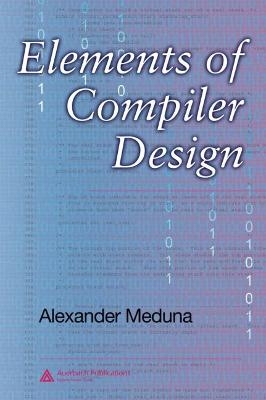
Elements of Compiler Design
Seiten
2007
Auerbach (Verlag)
978-1-4200-6323-3 (ISBN)
Auerbach (Verlag)
978-1-4200-6323-3 (ISBN)
- Titel ist leider vergriffen;
keine Neuauflage - Artikel merken
Providing both theoretical and practical approaches, this book offers a comprehensive introduction to compilers. It presents fundamental models underlying compilation and demonstrates the concepts, methods, and techniques based on these models. It examines the mathematical foundations of the theory of formal languages, automata, and transducers.
Maintaining a balance between a theoretical and practical approach to this important subject, Elements of Compiler Design serves as an introduction to compiler writing for undergraduate students. From a theoretical viewpoint, it introduces rudimental models, such as automata and grammars, that underlie compilation and its essential phases. Based on these models, the author details the concepts, methods, and techniques employed in compiler design in a clear and easy-to-follow way.
From a practical point of view, the book describes how compilation techniques are implemented. In fact, throughout the text, a case study illustrates the design of a new programming language and the construction of its compiler. While discussing various compilation techniques, the author demonstrates their implementation through this case study. In addition, the book presents many detailed examples and computer programs to emphasize the applications of the compiler algorithms.
After studying this self-contained textbook, students should understand the compilation process, be able to write a simple real compiler, and easily follow advanced books on the subject.
Maintaining a balance between a theoretical and practical approach to this important subject, Elements of Compiler Design serves as an introduction to compiler writing for undergraduate students. From a theoretical viewpoint, it introduces rudimental models, such as automata and grammars, that underlie compilation and its essential phases. Based on these models, the author details the concepts, methods, and techniques employed in compiler design in a clear and easy-to-follow way.
From a practical point of view, the book describes how compilation techniques are implemented. In fact, throughout the text, a case study illustrates the design of a new programming language and the construction of its compiler. While discussing various compilation techniques, the author demonstrates their implementation through this case study. In addition, the book presents many detailed examples and computer programs to emphasize the applications of the compiler algorithms.
After studying this self-contained textbook, students should understand the compilation process, be able to write a simple real compiler, and easily follow advanced books on the subject.
Brno University of Technology, Czech Republic
Preface. Introduction. Lexical Analysis. Syntax Analysis. Deterministic Top-Down Parsing. Deterministic Bottom-Up Parsing. Syntax-Directed Translation and Intermediate Code Generation. Optimization and Target Code Generation. Conclusion. Appendix. Bibliography. Indices.
| Erscheint lt. Verlag | 27.12.2007 |
|---|---|
| Zusatzinfo | 110 Illustrations, black and white |
| Verlagsort | London |
| Sprache | englisch |
| Maße | 178 x 254 mm |
| Gewicht | 771 g |
| Themenwelt | Mathematik / Informatik ► Informatik ► Programmiersprachen / -werkzeuge |
| Mathematik / Informatik ► Informatik ► Software Entwicklung | |
| Informatik ► Theorie / Studium ► Compilerbau | |
| ISBN-10 | 1-4200-6323-5 / 1420063235 |
| ISBN-13 | 978-1-4200-6323-3 / 9781420063233 |
| Zustand | Neuware |
| Haben Sie eine Frage zum Produkt? |
Mehr entdecken
aus dem Bereich
aus dem Bereich
a beginner's guide to learning llvm compiler tools and core …
Buch | Softcover (2024)
Packt Publishing Limited (Verlag)
CHF 69,80


